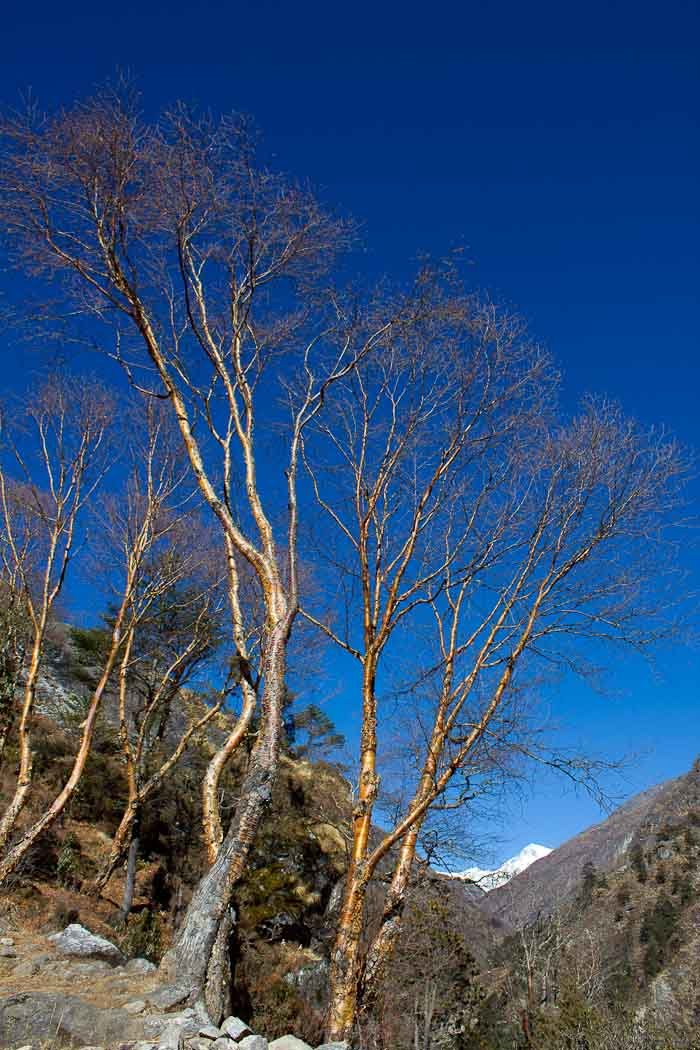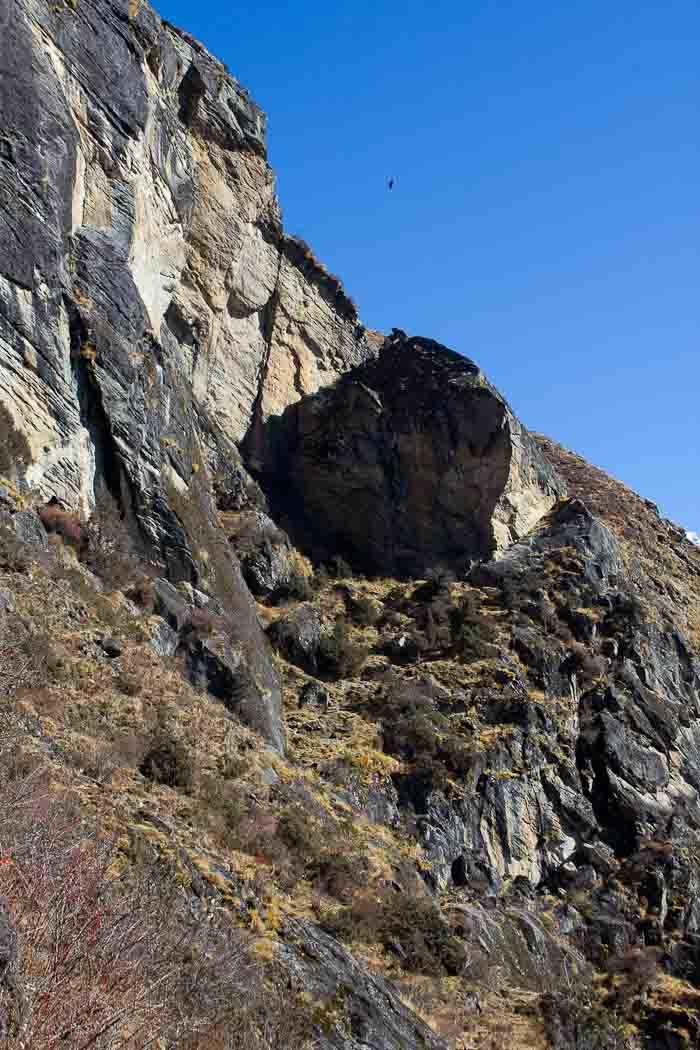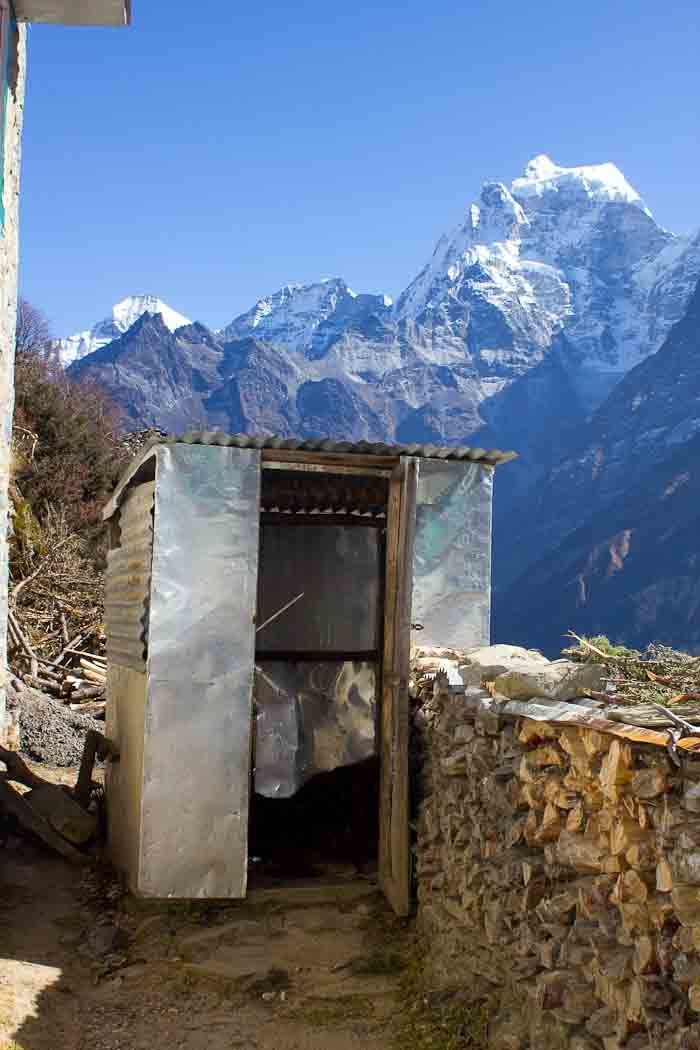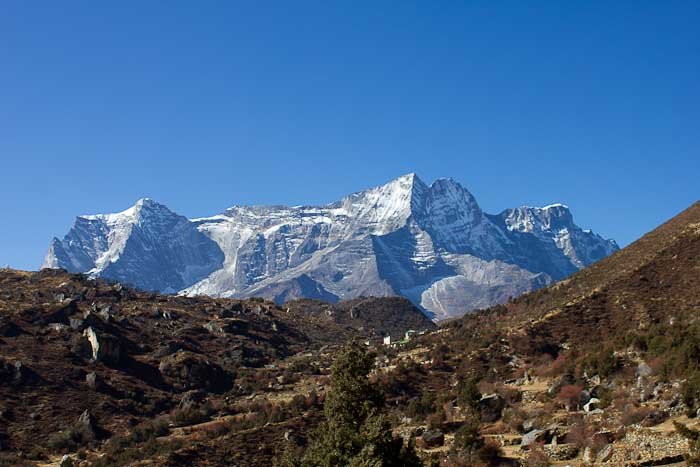Botanists and Glaciers
Botanists and Glaciers
Everest Base Camp The Lazy Way Day 6: Khumjung to Phortse Tenga
You don’t need to be a scientist to see climate change in action around Everest. We’re still below 4000m (13,100 feet) and already the scars that glaciers leave behind, slurried dark mats of pebbles and scree, are evident on the mountainsides.
The landscape is harsher here, but still agricultural: the villages and terraced fields have yet, quite, to give way to the summer pastures with their simple huts, there are still rhododendrons in the forest.
But the animals we see grazing now are still yak-cattle hybrids, not yaks, smaller, lighter, less furred creatures that prefer the temperatures and oxygen levels at this altitude.
Though the air is warm, ice particles cling to the red birch, and some of the mountain streams are already crusting with ice.

Nir offers us a choice between two routes out of Khumjung as we turn up the Gokyo Valley: the slower, easier route that winds down and then gently up, or a rock path that takes us up 150 vertical metres in a hand over hand scramble, cutting at one point between a boulder and its supporting cliff.
When we cross the Cho-La Pass, Nir says, we’ll need to do 400 vertical metres of this, starting at around 5000m (it’s roughly then, north of the 16,000 feet mark, that the partial pressure of oxygen in the air reaches half that of sea-level, and it’s then that we’ll hit a kilometre higher than either of us have ever been).
“Let’s do it for practice,” I say to Zac.
We take a lot of breaks and we’re not the fastest, but we make it over without any parts of our bodies screaming in protest — and, thanks to a judicious policy of not looking down, no vertigo — and so, on balance, I’m pleased.

In the little village of Mong-La – a chorten that doubles as yak parking, three lodges and a couple of summer herder huts – we’re eating lunch with a party of Nepali botanists we’ve bumped into on enough occasions now to count as friends.
They’re here to collect seeds, walking slowly up the valley, but they’ll be stopping below the treeline while we continue up into a world of rock and ice.
“We want to measure the impact of climate change on biodiversity,” one explains. His name’s Suraj, and he’s jolly not just with this walk amid his wonderful native landscape, but with the prospect of impending retirement.
“It’s very obvious here,” I say, gulping. It’s not just our high energy lifestyles that make me feel a little guilty at this point: we have flown not only into Kathmandu but also into Lukla.
“Yes,” Suraj says. “And this is one problem that Nepal has nothing to do with.”
For, despite all my whinges about pollution in Kathmandu, the resource use of this theoretically tiny country is minuscule.
Up here energy comes from solar panels or hydropower, neither streams nor sunshine being in short supply: if there’s power enough that day, you can pay a couple of dollars to charge a battery or two. If not? You do without.
This is, I figure, as I blench at the composting toilet, the way that life is going to be in future.

The youngest of the group is, maybe, in his mid-20s, and, embarrassingly, I’ve mistaken him for the older ones’ guide (you know: young, Nepali, and in the mountains – he’s got to be working in the tourist trade, rather than, say, someone with a doctorate in botany from the best university in town…).
They’re hoping to collect over 100 different types of seeds and are quietly optimistic that there will be a bunch of new species in there, once they’ve had time to put them under the microscope.
Nepal, apparently, which runs from sea level to, well, the highest point on earth, has more ecosystems than neighbouring India, which is more than 20 times its size– 118 at the last count.
“We will know the genus, of course,” explains Suraj. “But until we look closely, we’ll have no idea whether the species is new or not.”

We talk about what we’ve seen: pheasants, a myriad birds (this country’s a twitcher’s paradise), mountain goats, marmots, though so far no deer.
“I saw a leopard earlier,” says the younger guy.
“A LEOPARD?!” I say. “A snow leopard?!”
“No,” he says. “Just a leopard. By the path, on the way to Thame.”
I’m amazed again that there’s so much wonder to be found here: amazed as I am daily by the myriad permutations of mountains, every fifteen minutes a new view, the routine magic of rising every day and walking through the Himalaya…
Imagine that… Just seeing a leopard, by the path, slinking through the woodland, undisturbed.
And then I look across the path, to the residue of the glaciers that scar the savage black mountain tops that rise along the valley, snowcapped peaks behind them, frozen streams descending them, and I wonder how long there will be leopards here, how long there will be forest here, how long there will be people here to see it.
Use the “Previous” and “Next” post buttons below to navigate through this series. Or you can start from Day 1 of our Everest Base Camp trek, read Day 5 of our Everest Base Camp trek here or Day 7 here.
If you’re thinking of doing the Everest Base Camp trek, I recommend my Everest Base Camp FAQs.

Your article is so nice. Your photography shows the beauty of my Village Mong-La and Botanists and Glaciers.
My Wishes to your Himalaya Trip and Merry Christmas to all.
Thanks
Irina layik
Thanks, Irina.
Some beautiful photos. That toilet has one seriously amazing view!
However vile the toilets may be up here, they almost always have a view!
wow,sharing nice pictures of everest region…
wounderful…
The younger guy you mention in your blog is me..Sushil Bhandari. I told you that we have seen leopard…
Anyhow…great memory of treaking to everest while reading your blogs
ok keep it up
I don’t think you ever told me your name, Sushil! Thank you for commenting and good to hear from you. We’re actually meeting Suraj this afternoon and REALLY hoping you guys found some new species. So exciting!